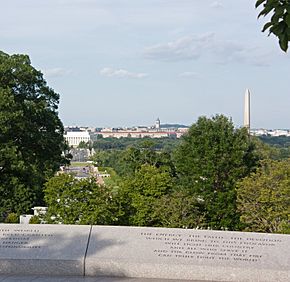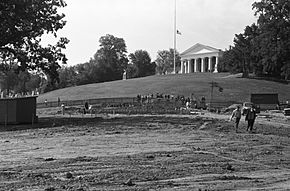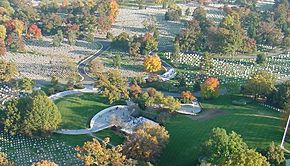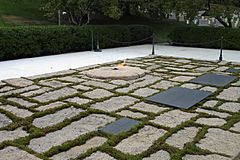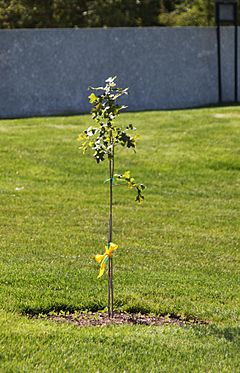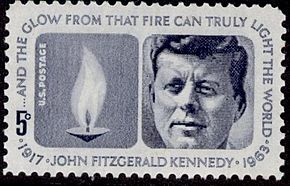John F. Kennedy Eternal Flame facts for kids
Quick facts for kids John F. Kennedy Eternal Flame |
|
|---|---|

The John F. Kennedy Eternal Flame at Arlington National Cemetery after its 2013 upgrade.
|
|
| Location | Arlington County, Virginia |
| Area | 3 acres (1.2 ha) |
| Established | November 25, 1963 (temporary) March 15, 1967 (permanent) |
| Governing body | U.S. Department of the Army |
| Lua error in Module:Location_map at line 420: attempt to index field 'wikibase' (a nil value). | |
The John F. Kennedy Eternal Flame is a special memorial at the grave of John F. Kennedy. He was the 35th president of the United States. His grave is located in Arlington National Cemetery in Virginia.
This permanent flame replaced a temporary one. The first flame was lit during President Kennedy's state funeral on November 25, 1963. This was three days after he was assassinated. A friend of the president, architect John Carl Warnecke, designed the site. The permanent John F. Kennedy Eternal Flame grave site opened to the public on March 15, 1967.
Contents
Choosing the First Grave Site
President Kennedy was killed on November 22, 1963. This happened in Dallas, Texas, during a trip. His body was brought back to Washington D.C. soon after. Important people from 92 countries came to his state funeral on November 25.
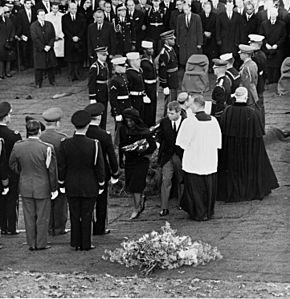
At first, news reports said President Kennedy would be buried in Brookline, Massachusetts. This was where his baby son, Patrick, was buried. Patrick had died shortly after birth in August 1963.
However, the burial place was quickly changed. It became a hillside below Arlington House in Arlington National Cemetery. Kennedy had visited this spot in March 1963 with his friend, John Carl Warnecke. The President had liked how peaceful the area felt.
The idea to bury Kennedy at Arlington may have come from Secretary of Defense Robert McNamara. First Lady Jacqueline Kennedy agreed to this change. Even though some family members wanted him buried in Massachusetts, his brother, Attorney General Robert F. Kennedy, visited the site. He decided that Jacqueline Kennedy's wishes should be followed.
The Idea for an Eternal Flame
On November 24, 1963, Jacqueline Kennedy asked for an eternal flame for her husband's grave. She got the idea from a few places. One was the eternal flame at the Tomb of the Unknown Soldier in Paris. She and her husband had seen it during a trip to France in 1961.
She was also inspired by a book called The Candle in the Wind. This book was part of the story for the musical Camelot. The Kennedys loved the music from Camelot. Her brother-in-law, Sargent Shriver, worried the flame might seem too showy. But Jacqueline Kennedy insisted on it.
The president's funeral was planned for Monday, November 25. This left very little time to set up an eternal flame. Overnight, a team from the United States Army Corps of Engineers built it. They used a propane gas-fueled tiki torch from a local gas company. They also installed a gas line to a propane tank about 200 yards (180 m) away. Evergreen plants were placed around the flame to hide the pipes.
The grave was in a grassy area about 5 yards (4.6 m) on each side. It was halfway up the hill where Arlington House stands. The grave was placed so it had a view of the Lincoln Memorial and Washington Monument. Jacqueline Kennedy lit the flame at the end of the burial service. Her husband's brothers, Robert and Ted, then symbolically lit it after her.
On November 26, a white picket fence was put around the site. The area was made larger. This was because Jacqueline Kennedy wanted her two deceased children, Patrick and Arabella, to be buried next to their father. Arabella was a daughter born stillborn in 1956. She had read that President Abraham Lincoln was buried next to his son. She remembered her husband wanted to be buried with his family.
Designing the Permanent Grave Site
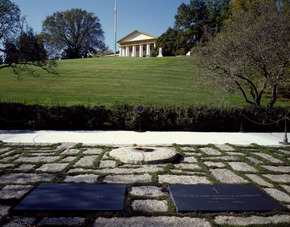
John Carl Warnecke, a friend of the Kennedys, visited the grave on November 28. He talked with Jacqueline and Robert Kennedy about plans for a permanent memorial. The next day, Jacqueline Kennedy chose Warnecke to design the tomb. Warnecke decided the permanent grave should be simple and include the eternal flame.
At first, there was concern that an eternal flame might not be allowed in the cemetery. But on December 3, 1963, the Army decided the Kennedy plot was not part of the main burial section. So, they allowed the eternal flame to stay.
The U.S. government officially set aside a 3 acres (1.2 ha) area around the grave on December 5, 1963. The design process was kept very secret. Warnecke studied hundreds of famous tombs and all other presidential burial sites. He talked with over 40 experts, including architects and sculptors. Jacqueline Kennedy worked with Warnecke many times on the design.
Warnecke wanted the eternal flame to be the main part of the site. He also wanted the design to be as simple as possible. He decided the grave site should not be a huge monument. Instead, it should be a respectful grave. This idea guided the final design.
The final design was shown to the public on November 13, 1964. It had been approved by the Kennedy family and government groups. The design aimed to show Kennedy's Catholic faith and the simple New England tradition of a flat headstone in the grass.
The design included a circular granite walkway. This walkway would lead visitors to the grave. A small oval plaza made of marble was at the top of the circle. A low wall with quotes from Kennedy's speeches would be on one side of the plaza. Marble steps would lead up to a rectangular terrace.
The graves would be in a slightly raised grassy area on the terrace. Flat black slate markers would show each grave's name and dates. A low retaining wall with the presidential seal would be at the back. The walkways and plaza were designed for over 50,000 visitors daily. The eternal flame would be in the center of the grassy plot. It would be in a flat, triangular bronze sculpture.
Building the New Grave Site
Construction was planned to start in fall 1965 and finish by fall 1966. President Kennedy's body and his children's bodies needed to be moved about 20 feet (6.1 m) downhill. An old oak tree in the pathway was kept. The total cost was estimated at $2 million. The Kennedy family offered to pay for it all, but the government asked them to pay only for the grave itself, about $200,000–$300,000. Most of the cost was for making the site strong enough for many visitors.
The Washington Gas and Light Company offered to build and maintain the eternal flame for free. The final burner was specially designed. It had an electrical ignition system that kept the flame lit in wind or rain. It also fed oxygen to the gas for the right flame color.
Construction began in mid-July 1965. The white marble for the plaza and steps came from Proctor, Vermont. The granite for the paths came from Deer Isle, Maine.
Some changes were made before construction finished. The retaining wall behind the grave was removed. This gave a clear view of Arlington House. Also, the grass on the burial plot was replaced with reddish-gold granite fieldstone. This was because the grass might not survive Washington's hot summers. These fieldstones came from Cape Cod, where President Kennedy spent summers.
Building the paths meant changing the hill's slope. Workers had to use picks and shovels carefully around the oak tree to protect its roots. The roots were reinforced with concrete, but a system was added to let them still get air and water.
Twenty tons of steel and 280 tons of concrete were used for the terrace and grave vaults. The first fieldstones for the graves were placed on April 11, 1966. Jacqueline Kennedy, with help from Ted Sorensen, chose quotes for the low stone wall. All quotes came from Kennedy's 1961 inaugural address. John E. Benson carved the quotes onto the granite blocks. By mid-October 1966, delays meant the site would open in early 1967.
Opening the New Grave Site
The permanent John F. Kennedy grave site opened quietly on March 15, 1967. A few days before, the eternal flame was moved to its new spot. The reburial of the bodies happened on the evening of March 14, after the cemetery closed. The burial vault was lifted from the old grave and placed in the new one. This was done privately.
The reburial was witnessed by U.S. senators Robert and Ted Kennedy. The new site was officially blessed at 7:00 AM on March 15, 1967. It was raining. President Lyndon B. Johnson, Jacqueline Kennedy, and other Kennedy family members attended the 20-minute ceremony. The total cost of the project was $2.2 million.
Changes to the Site
Robert F. Kennedy was killed on June 6, 1968. An expansion to the John F. Kennedy grave site was built in 1971 for Robert Kennedy's grave. His resting place is about 50 feet (15 m) southwest of John F. Kennedy's terrace. Robert Kennedy's grave is marked by a white cross and a slate headstone.
Across from his grave is a granite plaza designed by architect I. M. Pei. It was dedicated on December 6, 1971. A low granite wall there has quotes from Robert F. Kennedy's speeches. There is also a small reflecting pool.
The paths to the Kennedy grave site were changed when Robert F. Kennedy's memorial was built. They used to have many steps. But in June 1971, the steps were replaced with long ramps. This made the site easier to access for people in wheelchairs.
Jacqueline Kennedy Onassis was buried next to her husband after she died in May 1994. Senator Edward M. Kennedy was buried about 100 feet (30 m) south of Robert Kennedy's memorial. This happened after his death on August 25, 2009.
The Arlington Oak
A 220-year-old tree called the "Arlington Oak" stood near the Kennedy memorial. It was uprooted and killed by Hurricane Irene on August 27, 2011. The grave site was closed for two days to remove the tree.
On Arbor Day, April 27, 2012, a young tree grown from an acorn of the original Arlington Oak was planted there. Other saplings from the same oak were planted nearby in the cemetery.
Keeping the Flame Burning
Keeping the eternal flame burning is an ongoing task. In 2001, experts said it cost about $200 a month to maintain. A company called Fenwal Controls is responsible for its upkeep. The flame has a special ignition system. It keeps the flame lit even in wind or rain. If the flame goes out, the system sparks to relight it.
In late 2012, the eternal flame started having problems. On January 31, 2013, a company called Meltech Corporation got a $350,000 contract to upgrade it. During this work, the permanent flame was put out. A temporary flame was displayed to the side. This was the first time a temporary flame was used since the permanent one was installed.
The flame was moved back to the upgraded permanent site on May 17, 2013. The upgrade replaced the old burner. It also laid new gas lines and electrical cables. This made the flame more energy-efficient.
In November 2010, the carved quotes on the stone wall were restored. Weather had made the letters hard to read. The Knights of Columbus donated $6,000 to have the letters darkened and carved deeper. This was done for the 50th anniversary of Kennedy's inauguration.
The Emigrant Flame
In 2013, the eternal flame was shared for the first time. On June 18, an Irish government official lit a lamp from the eternal flame. This "spark" then traveled to Ireland on a special flight.
The "spark" arrived in Dublin Airport on June 20. It was then taken by an Irish Naval vessel up the River Barrow to New Ross. This is the town where John F. Kennedy's great-grandfather came from in 1848.
On June 22, some Irish Special Olympians carried the flame. They took it from the ship to a ceremony at the Kennedy Homestead. Irish leaders and Kennedy family members used the burner to light an "Emigrant Flame." This marked 50 years since President Kennedy's trip to Ireland. The Emigrant Flame is now a main part of the homestead visitor center.
How the Site Influenced People
Right after Kennedy's burial, about 50,000 people visited the eternal flame every day. More than 16 million people visited in its first three years. In 1971, over 7 million people came to the site.
The grave also made Arlington National Cemetery much more popular. President Kennedy's 1963 funeral was shown live on TV. About 93 percent of American homes watched it. Satellites sent the broadcast to 23 other countries, where 600 million more people watched. This TV coverage turned Arlington National Cemetery from a quiet burial ground into a major tourist spot. Yearly visitors jumped from 1 million in 1962 to 9 million in the first six months of 1964.
In 1964, the United States Post Office Department used a picture of the eternal flame on a postage stamp. This stamp honored the assassinated president. It also included words from Kennedy's inaugural speech: "And the glow from that fire can truly light the world."
The Kennedy eternal flame has also attracted some unusual attention. In 1981, the cross and headstone from Robert F. Kennedy's grave were stolen. They were never found. In 1982, a man broke into the cemetery at night. He had a heart attack and fell into the flame. In 1997, thieves tried to steal a heavy paving stone from the terrace. But they gave up because the 500-pound (230 kg) stone was too heavy.
See also
 In Spanish: Llama Eterna de John F. Kennedy para niños
In Spanish: Llama Eterna de John F. Kennedy para niños


